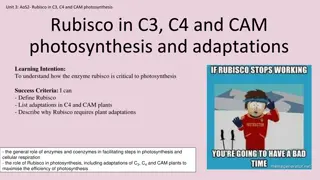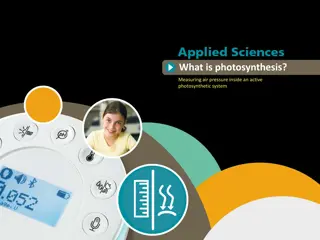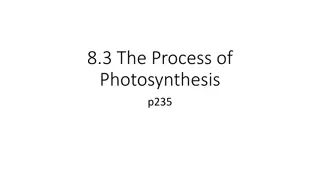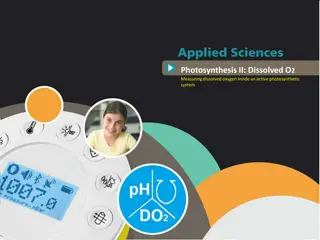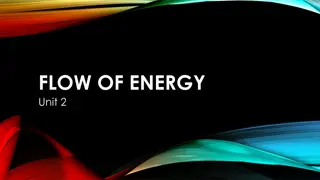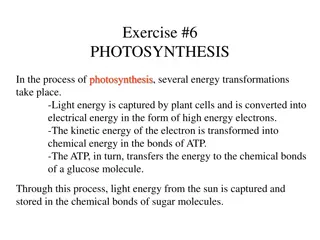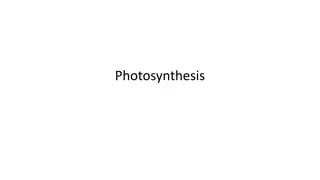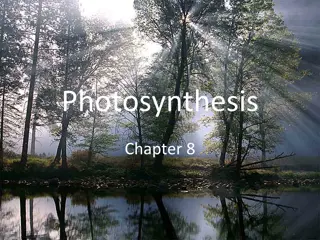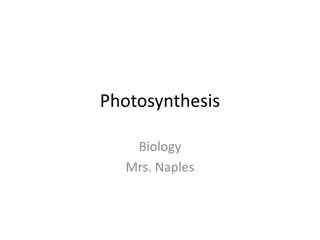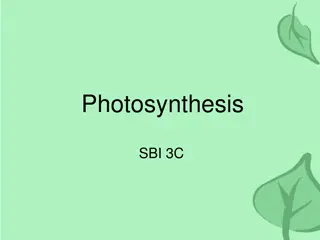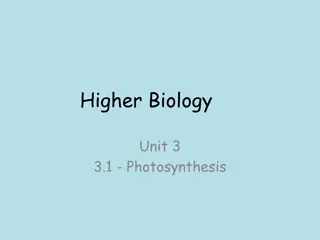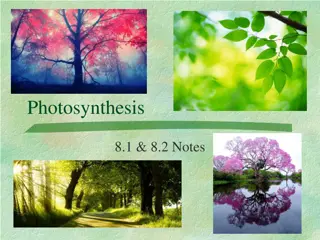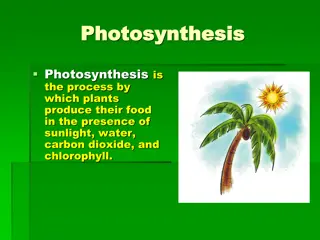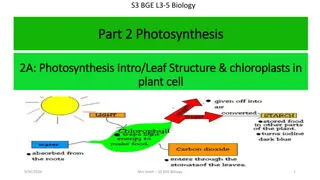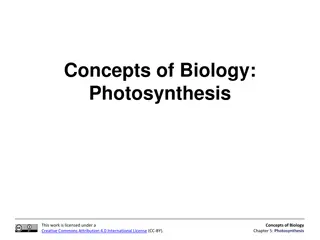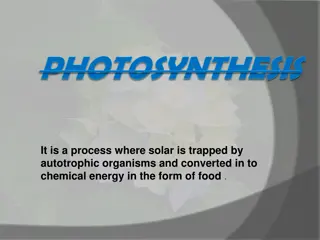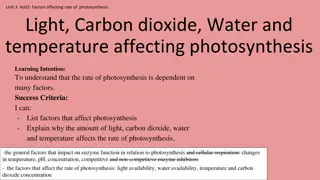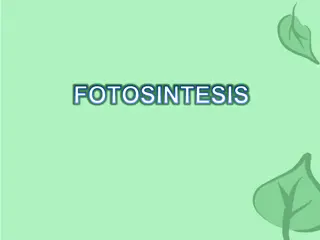Understanding Photosynthesis: Process, Importance, and Stages
Photosynthesis is a vital process where plants make their own food using carbon dioxide, water, and light energy. It plays a crucial role in producing oxygen, removing carbon dioxide from the air, and forming fossil fuels. The balanced equation for photosynthesis shows how glucose and oxygen are produced. This process requires chlorophyll and occurs in stages involving light absorption, water splitting, and glucose formation. The significance of photosynthesis lies in its ability to convert light energy into chemical energy, essential for plant growth and ecosystem balance.
Download Presentation

Please find below an Image/Link to download the presentation.
The content on the website is provided AS IS for your information and personal use only. It may not be sold, licensed, or shared on other websites without obtaining consent from the author. Download presentation by click this link. If you encounter any issues during the download, it is possible that the publisher has removed the file from their server.
E N D
Presentation Transcript
Photosynthesis Plants making their own food
Role of Photosynthesis Plants use it to make food Animals get their food from plants It produces oxygen which is needed in respiration to release energy It is responsible for forming fossil fuels It removes carbon dioxide from the air
Balanced Equation for Photosynthesis 6CO2+ 6H2O + light C6H 12O6+ 6O2 water glucose Carbon dioxide oxygen
Photosynthesis requires: carbon dioxide, water, light energy, chlorophyll.
Photosynthesis produces glucose waste oxygen
Photosynthesis converts light energy chemical energy
Stages in Photosynthesis 1. Light is absorbed 2. Water is split 3. Products are produced (4 protons, 4 electrons and oxygen) 4. Light energises electrons 5. Glucose is formed
Light is Absorbed The light that reaches a plant is trapped by chlorophyll Chlorophyll is found in the chloroplasts of plant cells Therefore photosynthesis occurs in chloroplasts The trapped light provides the energy the plants need to make glucose
Water is Split Some of the trapped light energy is used to split water into oxygen gas (O2) protons (H+) and electrons (e-) Summarised as 2H2O 4H+ and 4e- and O2
What happens to these Products? 1. The electrons are passed to chlorophyll 2. The protons are stored in a proton pool for later use 3. The oxygen may pass out of the leaf into the atmosphere or else may be used for plant respiration
Light Energises Electrons The electrons that were passed to the chlorophyll become energised by some of the trapped light energy -- this changes them into high energy electrons
Glucose is formed The high energy electrons along with protons from the proton pool are combined with carbon dioxide to form glucose (C6H 12O6 )
Sources of light for plants Sunlight is the natural source of light for plants but they can use artificial light for photosynthesis Artificial light is often used in greenhouses stimulate growth Increasing light can increase growth up to a certain saturation point where no more light can be absorbed and photosynthesis will level off
Sources of carbon dioxide for plants Plants have 2 sources of carbon dioxide one is external the other is internal Plants get most of their carbon dioxide from the atmosphere this is external Plants get carbon dioxide internally from their own cellular respiration Sometimes artificial sources of carbon dioxide are used to stimulate growth eg. burning gas in a green house
Sources of water for plants Water is absorbed from the soil by the roots of plants This water passes up the stem and is used for photosynthesis
2 stages of Photosynthesis (HL) Photosynthesis Light Stage Dark Stage
Light Stage (HL) This takes place in the grana of the chloroplast It involves the very fast movement of electrons and is not controlled by enzymes Light is absorbed by a range of pigment clusters found in the chloroplast (almost all colours of light are absorbed but green is normally reflected)
Light Stage (HL) This light energy is transferred to the electron that has been passed to the chlorophyll This chlorophyll is in the pigment cluster and is strategically placed near an electron acceptor The pigment cluster absorbs as much light energy as possible and passes it to the chlorophyll which passes it to the electron The energised electron is passed to the electron acceptor which can the send it on one of two pathways
Electron Flow Pathway 1 (HL) In pathway 1 the electrons pass from the first electron acceptor to a series of other electron acceptors and back again to the chlorophyll As the electrons are passed around they lose energy This energy is used to join a phosphate to ADP to form high energy ATP Water is also formed in this process
Electron Pathway 1 (HL) ADP + Energy + P ATP + Water The addition of phosphate to ADP is called phosphorylation Because the electron travel in a cycle and returns to its original chlorophyll this process is called Cyclic Phophorylation
Electron Pathway 2 (HL) 2 high energy electrons at a time are passed from chlorophyll to the electron acceptor and then along another series of electron acceptors In this case the electrons do not return to the original chlorophyll They lose energy as they pass from electron acceptor to electron acceptor and this energy is used to make more ATP
Electron Pathway 2 (HL) Eventually the 2 electrons are passed to combine with NADP+ to form NADP- The chlorophyll molecule is now short of electrons and gains more from the splitting of water The splitting of water using light energy is called Photolysis
(HL) The protons that were stored in the proton pool are attracted to NADP- and combine with it to form NADPH Because the electrons start at a chlorophyll and finish at NADPH and form ATP on their way this pathway is known as Non cyclic photophosphorylation
Light stage (HL) Light Stage Photolysis Splitting water Phosphorylation Making ATP
Phosphorylation (HL) 5: 1: Hydrogen ions join with NADP- To form NADPH Chlorophyll traps sunlight 4: 2: Other electrons join with NADP To form NADP- Electrons are energised 3: Electrons lose energy to ADP Which joins with P to form ATP
Photolysis (HL) The splitting of water Water H20 Hydrogen ions H+ Electrons E- Oxygen 02 Used to convert NADP To NADPH By product Excreted through leaf Go back to chlorophyll
End Products of the Light Stage (HL) There are 3 end products of the light stage 1. ATP this will provide energy for the dark stage 2. NADPH this will provide protons + energised electrons for the dark stage 3. Oxygen is made when water is split
Dark Stage (HL) This may also be called the light independent stage as it can occur in the light but does not need to use it It takes place in the stroma of the chloroplast It is controlled by enzymes and therefore can be affected by temperature
Dark Stage (HL) Carbon dioxide from the air enters the chloroplast where they combine with protons + electrons to form glucose This needs energy and protons + electrons
Dark Stage (HL) It uses energy got from breaking down ATP into ADP + P It uses hydrogen ions and electrons got from breaking down NADPH into NADP+ +2 electrons + H+
Dark Stage (HL) Remember the addition of electrons to anything is known as reduction Carbon Dioxide is reduced to glucose
Dark Stage (HL) CO2 is reduced Oxygen atom is removed Hydrogen ions are added Electrons are added Glucose is formed C6H1206
Main events in photosynthesis (HL) Light energy is absorbed by chlorophyll Water is split The electrons are passed to chlorophyll The protons are stored in the chloroplasts The oxygen is released Sunlight transfers energy to electrons The high energy electrons, stored protons( the hydrogen ions) and carbon dioxide are used to make glucose

 undefined
undefined




